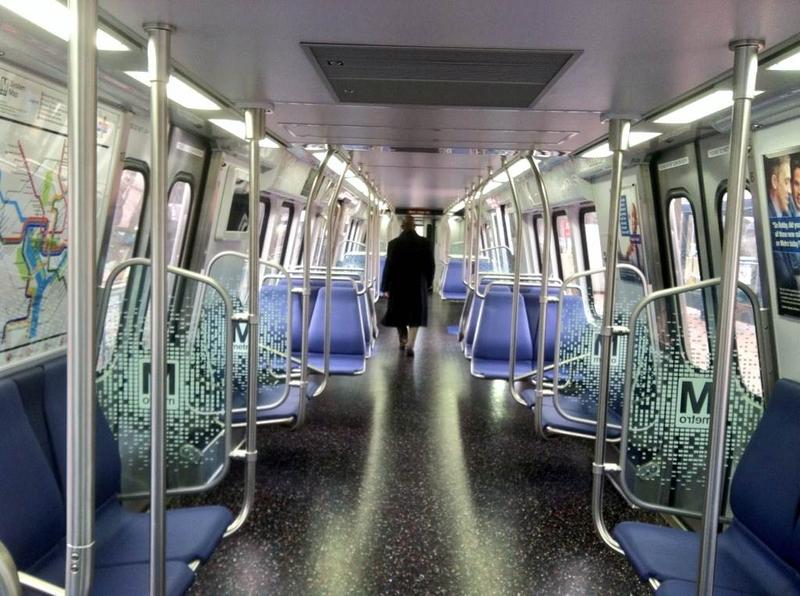
Its 1970s-era rail cars creaking with age, Metro finally stepped into the 21st century on Monday, as the transit authority unveiled the first four in its fleet of modern trains scheduled to begin carrying passengers by the end of the year.
At a news conference on the frigid Greenbelt station platform, flanked by mostly Democratic elected officials and political appointees from Maryland and D.C., Metro general manager Richard Sarles heralded the arrival of the 7000-series rail cars, built in Kawasaki’s plant in Lincoln, Nebraska.
The stainless steel cars with non-slip flooring (no carpets!), digital signage and public address systems will be tested for several months, and the rest of the new fleet is expected to begin rolling off Kawasaki’s assembly line in the fall. The 528 7000-series cars on order will cost $1 billion. Combined with an additional 220 cars Metro hopes to order in 2015, pending the availability of funding, more than half of Metro’s fleet would be comprised of 7000-series trains in five years.
(photo by Martin Di Caro)
“These cars are replacing 40-year-old rail cars that are unreliable and cause delays today. So instead of matching the old design, we decided to make a clean break and create a car with the future of Metro in mind,” Sarles said. “The new cars are safer and more customer-friendly than the cars in service today, providing a new level of technology and on-board amenities for riders.”
The introduction of the 7000-series over the next five years will enable Metro to fulfill a key federal safety recommendation stemming from the 2009 Red Line crash that killed one train operator and eight passengers: all 300 of the old 1000-series cars, which were involved in the fatal episode, will be replaced. The last 1000-series car will be taken out of service within three years, Sarles said.
Metro has fulfilled 20 of the 29 National Transportation Safety Board recommendations born from the federal agency’s crash investigation.
The new cars will also accommodate ridership on the Silver Line, the rail extension through Tysons Corner (VA) expected to open late winter or early spring. The problematic 4000-series also will be replaced.
The 7000 series rail cars are designed to minimize the life-threatening impact of crashes.
“It actually transfers most of the energy into the car body and protects the passengers and the people on board. It does this through improved crash-worthiness designs, crash attenuation, and improved couplers. But it also allows for better emergency egress in the event of an accident and emergency access from first responders both from inside and outside the car,” said NTSB chairman Deborah Hersman, who praised Metro for making progress in improving safety.
However, the call to replace the 1000-series predated the 2009 disaster. The NTSB first recommended their replacement in 1996, Hersman said.
“Unfortunately, what we see in our accident investigations is that it often takes a very significant event to change public perception and to create a will to do something,” Hersman said. “Metro wanted to replace those cars. They just didn’t have the funding to do so. In 2009, it became deadly apparent to everyone that those cars were inadequate and something needed to be done.”
The NTSB determined the proximate cause of the fatal Red Line crash was the failure of Metro’s signaling system, known technically as parasitic oscillation. The train that was struck from behind in Northeast, D.C. on June 22, 2009 vanished from the computer tracking system that controlled Metro’s trains, so the second train was unable to detect that it was still on the tracks.
The NTSB recommendation to completely rehabilitate the signaling system so Metro can return to automatic train operation (ATO) remains open, pending a safety review underway now. Metro has made progress toward returning to ATO through the ongoing correction of its signaling, Hersman said.
Metro officials also point out it is the only transit system in the U.S. that operates a loss-of-shunt detection system, which is the failure of a track circuit to detect the wheels and axles of a train. Also, Metro has replaced track circuit modules to allow the NTSB to close out the corresponding safety recommendation. The signal system is providing for safe train operations in manual mode today, Metro says.
When asked if passengers should be confident the old rail cars are safe to board until their replacement, Hersman said: “I’m a regular Metro rider. I want the system to be as safe as possible. Metro is taking many good steps to improving its system.”
While Monday’s news conference was heavily attended by prominent Democrats representing Maryland and D.C. in Congress and at the state, county, and city level of government, Virginia’s Republican Governor Bob McDonnell and Transportation Secretary Sean Connaughton were absent.
A spokeswoman for McDonnell, who officially leaves office Saturday, said the governor “had other commitments in Richmond today.” Secretary Connaughton said a scheduling conflict prevented him from attending, but praised the arrival of the new rail cars in a statement.
“The delivery of these cars is a positive step forward for improving Metro passenger safety and service. It is, however, just a step. The region needs to work together and make further investments in the Metro system to guarantee safety and ensure its continued success,” the statement said.
